Rome in 3 Days: Best Itinerary for First-Time Visitors
Artsy Traveler contains affiliate links for products and services I personally use and can happily recommend. As an Amazon Associate, I earn from qualifying purchases. Please read the Disclosure for more information. If you make a purchase through these links, at no additional cost to you, Artsy Traveler earns a small commission. Thank you!
Three full days in Rome doesn’t come close to doing justice to the Eternal City, but it’s better than one day.
After all, Rome wasn’t built in a day so don’t try to see all of it in a day. You’ll exhaust yourself and come away feeling ripped off.
Rome deserves time. It’s a city that overwhelms, but in the best possible way. Around every corner lies another ancient ruin, Baroque fountain, or tempting trattoria.
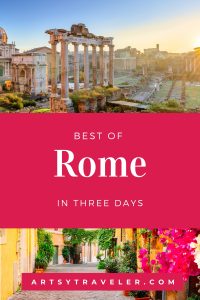
If it’s your first time in the Eternal City and you have just three days, this post will help you make every moment count.
It includes tips for visiting the top sites: the Colosseum and Roman Forum, St. Peter’s, and the Vatincan, but also leaves time for sipping espresso in a sunny piazza, and exploring some off-the-beaten path gems.
I’ll show you how to organize your time so you see Rome’s essential sights without feeling rushed—complete with skip-the-line tours, transport passes, and tips on where to stay, eat, and soak up that unmistakable Roman magic.
I’ve visited Rome many times, and consider it one of my favorite European cities. On every visit, I find something new to enjoy.
Quick Facts – 3 Days in Rome
- Best time to visit: April-May and mid-September to October for lighter crowds and pleasant weather
- Ideal number of days: 3 full days to cover the highlights at a relaxed pace
- Must-book tours/passes: skip-the-line Colosseum & Roman Forum, Vatican Museum & Sistine Chapel, city sightseeing bus or metro day pass.
- Best neighbourhoods to stay: Monti (close to Colosseum), Trastevere (evening/night charm), near Spanish Steps / Piazza del Popolo (central and elegant).
- Daily walking estimate: ~5-8 km each day (comfortable shoes essential).
Where to Stay in Rome for 3 Days
Here are the three areas I recommend you stay in while visiting Rome:
- Monti – right by the Colosseum & Forum and well served by buses and taxis; book an apartment and settle in as a temporary local.
- Piazza Navona – a bit crowded, but right in the center of the action. Check out Torre Capranica for a great stay in a 14th century renovated tower.
- Spanish Steps / Piazza del Popolo area – more elegant, great for exploring via foot, upmarket hotels. I loved Viam 6B – spacious suites, some with terraces.
Why Visit Rome?
Visit Rome because, for many hundreds of years, it was the center of the ancient world and has the awe-inspiring archeological sites to prove it.
Visit Rome because it’s the center of the Catholic world and boasts some of the world’s most beautiful and meaningful churches.
Visit Rome because the locals are both reserved and helpful so long as you meet them halfway with a few Italian phrases and a respectful attitude.
Visit Rome to wander through fabulous museums such as the Capitoline, the Etruscan Museum (my favorite), and more.
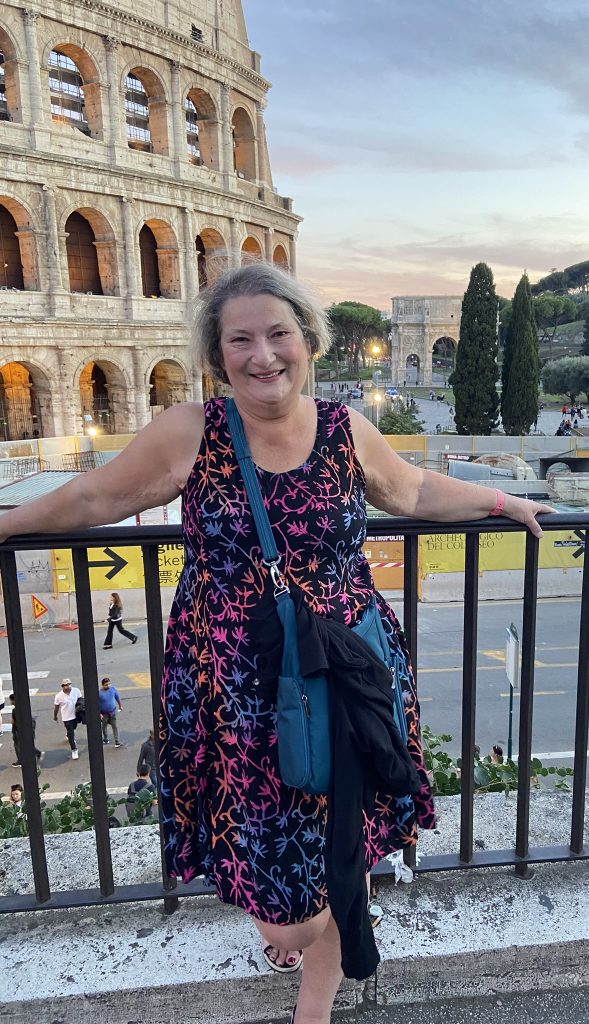
Visit Rome to enjoy some of the world’s most beautiful art, from the Sistine Chapel in the Vatican to the Bernini sculptures at the Borghese Museum to Michelangelo’s Pieta in St. Peter’s Basilica.
Visit Rome to enjoy quiet dinners in tucked away piazzas where most of the conversations at the tables around you are in Italian.
Visit Rome to wander back streets that don’t look like they’ve changed for centuries.
Don’t even think about trying to “do” Rome in a single day—or worse, in a rushed afternoon between flights. You’ll only see the crowds, the heat, and the chaos, and you’ll miss everything that makes Rome so special.
Rome is so much more than lines at the Colosseum and overpriced cappuccinos near the Trevi Fountain.
Rome is real, timeless, and endlessly inspiring.
Best of Rome at a Glance
- Staying in Sant Angelo Apartments in the Jewish Ghetto
- Exploring the Trastavere
- Checking out Domus Aurea
- Visiting the Borghese Gardens
- Getting out of town to explore the Appian Way
When to Visit Rome
Avoid Rome in the middle of the summer if at all possible. Temperatures can soar into the 40’s, which makes sightseeing miserable. Crowds overrun major sites, and people can get very grumpy.
Choose the shoulder seasons to visit Rome: April and May or September and October. I’ve also visited Rome in December and it was marvelous. Sunny days and crisp, cold nights allowed for exhilarating sightseeing with far fewer crowds.
No matter when you visit, you’ll need advance tickets for the big ticket sites: the Colosseum & Forum and the Vatican Museum. Here are some options:
Arriving in Rome
There are three ways to get to Rome: by car, by train, and by plane. You could also walk, but the last kilometers into the city probably wouldn’t be very scenic!
Driving to Rome
Do not even attempt to drive in Rome. First off, you’ll get a ticket and a hefty fine for driving into the ZTL (the Traffic Limited Zone) and second, you may get overwhelmed by the heavy traffic.
I drove once into Rome to an apartment I’d rented near the Vatican. Fortunately, I didn’t drive into the ZTL, but we did get into a horrendous traffic jam. As soon as I saw a “P” for Parking, I pulled into the garage and parked the car for the full week of our stay.
If you’re driving, park your car on the outskirts of Rome in a secure lot. I use the Parclick app (highly recommended) to find a suitable parking lot at a reasonable price.
Choose a secure, staffed lot with a good rating, navigate to it, park your car, give the keys to the attendant, and then take a taxi to your accommodations in Rome.
Avoid the temptation to stay at a cheaper hotel on the outskirts, even if it includes free parking. You’ll spend half your day commuting to and from central Rome, which is not a great use of your sightseeing time.
See below for more about recommended neighborhoods to stay in central Rome.
Arriving in Rome by Train
If you’re taking the train, you’ll arrive at Rome Termini train station. From there, you can take a taxi to your accommodation.
Arriving in Rome by Plane
Rome’s Fiumicino airport is about 30 km from central Rome. The easiest way to get from the airport to your accommodation is to take a taxi for a flat fixed rate of €48 for all journeys that end within the Aurelian Walls, which is pretty much anywhere within the city center.
The fastest way if you don’t have a lot of luggage is to take the Leonardo Express, which runs every 15 minutes and takes around 32 minutes to get to Termini station.
Here are some options fo purchasing your transport from the airport into Rome in advance:
On a solo trip to Rome, I booked a private transfer from the airport to my accommodation near the Borghese Gardens. A guy carrying a sign with my name on it met me, picked up my case, ushered me outside to his air conditioned car, and an hour later after negotiating a ferocious traffic jam, dropped me at the door of my accommodation. I didn’t have to worry about finding the taxi rank or watching the meter chug ever higher since my private transfer was a fixed price.
I’m a big fan of prebooking private transfers, especially if you’re arriving after a long flight.
Getting Around Rome
You’ll walk a lot in Rome, and that’s part of the fun! When you get tired, hop on a bus or the metro, or take a taxi.
I often take taxis because they are easy to find at taxi ranks and are reasonably priced. Taxi drivers skillfully weave through the dense traffic–better them than me!
Busses in Rome are also a good bet. Use your phone to familiarize yourself with the bus routes. I prefer riding the bus to riding the metro (which has limited routes) because then I can watch Rome go by.
You can also choose the Hop-On Hop-Off Bus, which can be good value with access to three circuits with a single ticket. Here’s a link from GetYourGuide:
Rome Passes
With only three days in Rome, you need to be strategic. Consider purchasing a pass that also includes public transport. Here’s one that includes skip-the-line access to the Vatican, personalized planning assistance, and entry to the Roman Forum among other sites.
A Three-Day Rome Itinerary
My three-day Rome itinerary provides you with suggestions about what to do and see if you arrive around lunchtime on day one and then spend two full days and three nights in Rome.
Day 1: Ancient Rome
You could easily spend several days just focusing your sightseeing energies on ancient Roman sites and museums. They’re everywhere!
Top of the list are the Colosseum and the Forum, along with the Pantheon and if you have time, at least one museum. My top choices are the Etruscan Museum (my favorite), the Capitoline Museum and the National Roman Museum.
If you have the time and energy, another highlight is the Domus Aurea. You must reserve well in advance of your visit.
Colosseum and Forum
Visit the Colosseum and wander through the Forum fairly late in the day when the crowds may have lessened.
Also known as the Flavian Amphitheatre, the iconic Colosseum has become the symbol of Rome. Construction of the Colosseum began in AD 72 by order of the Emperor Vespasian and was completed in AD 80. It was the largest colosseum in the world with a capacity of 50,000 spectators.
Seeing it now, you’ll be hard-pressed to believe it held that many people.

To be honest, I was a bit underwhelmed the first time I saw the interior of the Colosseum. My imagination couldn’t quite conjure the scenes of wild animals tormenting terrified Christians, which is probably just as well.
That said, you have to see it at least once. I recommend you purchase a skip-the-line ticket in advance. You can also choose a tour, although my experience of taking a guided tour of the Colosseum was not great. See my post How Not To Tour the Colosseum for details.
Another option for your first day in Rome is to book a sunset tour of the Colosseum that takes you to the Colosseum’s underground corridors, the arena, and the first ring of the seating area. Here’s an option from GetYourGuide:
Domus Aurea
The Domus Aurea is in the vicinity of the Forum and Colosseum. I visited the Domus Aurea in 2001, not long after it opened in 1999 and was able to wander freely around the massive excavated rooms. The site was closed in 2005 and reopened in 2007, with more galleries added in 2015. The number of visitors is now restricted.
Built by the Emperor Nero in 64 AD, the Domus Aurea had 300 rooms and occupied about 50 hectares, and was used exclusively for parties. That Nero was some kind of party animal. Little is left of the palace’s former glory, but a tour there is recommended to learn about a fascinating period in Roman history.
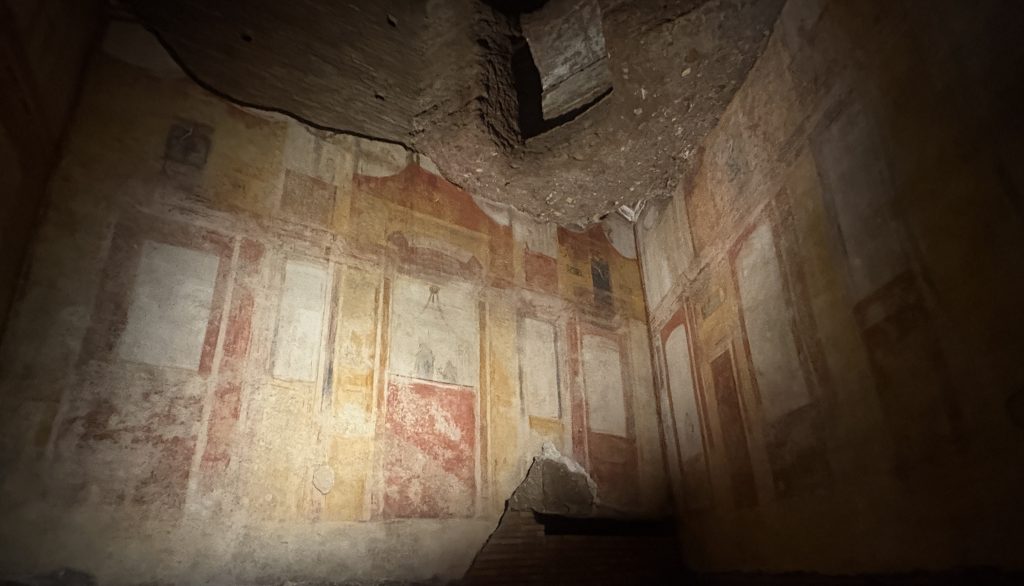
Visit the Domus Aurea by guided tour. Most tours include a virtual reality installation in the Sala della Volta Dorata that I found fascinating. You’ll be transported to an ancient, rich, and magical world.
Tip: Book the Domus Aurea tour as far in advance as possible. Choose a time later in the day and then follow the visit with a late-afternoon/early-evening tour of the Colosseum and the Forum.
Pantheon
The area around the Pantheon in central Rome is always hopping. Visit later in the day when the crowds are thinning, or wait and visit the Pantheon on your second day in Rome when you explore medieval Rome and the Piazza Navona.
The Pantheon is remarkable for its dome, which is still the world’s largest unreinforced concrete dome. Thanks to continuous use for two millennia, the Pantheon is one of the best-preserved buildings from ancient Rome. Originally a temple, the Pantheon is now a church.
See the Pantheon on your own or, for a few euros more, take a guided tour.
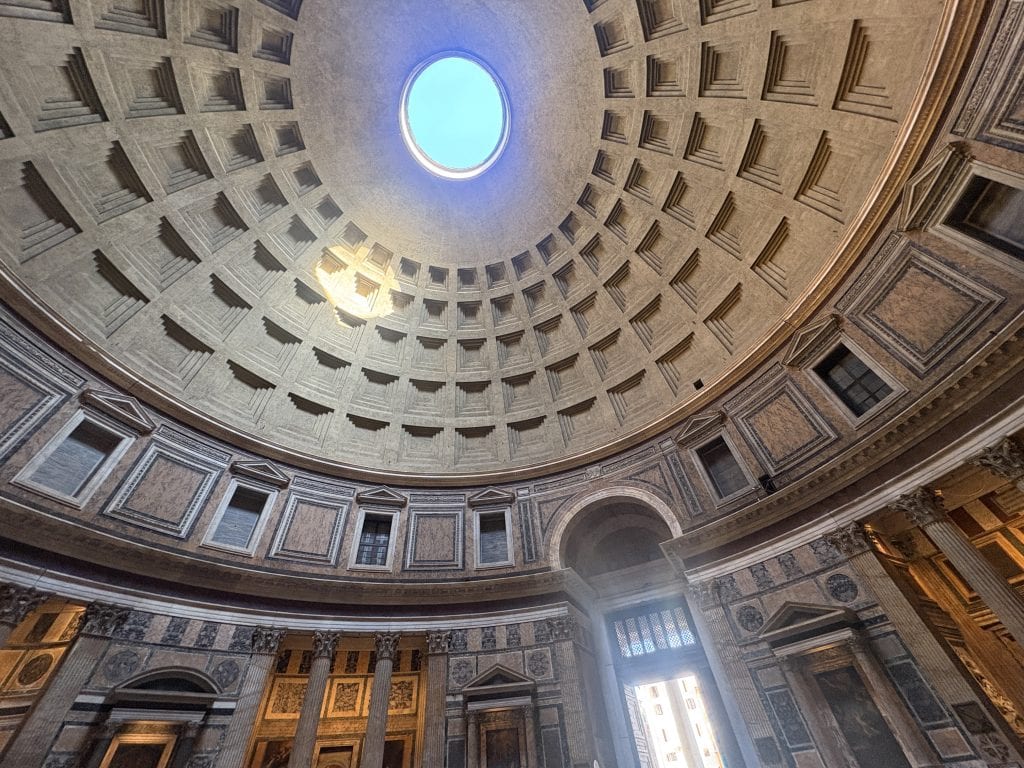
After touring the Pantheon, treat yourself to a gelato and watch the world go by from one of the cafés bordering the piazza in front of the Pantheon. I still remember fondly the fig gelato I sampled while visiting the area.
Avoids Crowds and Check Out a Museum
If you pefer to avoid crowds, I’m going to get radical here and suggest you skip touring the Colosseum and the Forum altogether, especially if the weather is hot.
Instead, visit one or two of these three awesome museums, each of which will give you plenty of insights into ancient Roman and Etruscan art and artifacts in air-conditioned comfort with virtually no crowds.
Capitoline Museum (Musei Capitolini)
Twin palaces designed by Michelangelo house one of the world’s oldest public art collection and a must-vsit for lovers of classical sculpture. Highlights include the bronze equestrian statue of Marcus Aurelius, the Capitoline Wolf, and the mesmerizing Dying Gaul.
National Roman Museum (Museo Nazionale Romano)
Spread across several locations including Palazzo Massimo alle Terme, Palazzo Altemps, Baths of Diocletian, and Crypta Balbi, the National Roman Museum traces daily life, art, and luxury in ancient Rome. Highlights include exquisite mosaics, frescoes from the Villa of Livia, and hauntingly lifelike marble portraits of emperors.
If you only have time for one branch, visit Palazzo Massimo near Termini Station. It’s manageable, beautifully curated, and blissfully uncrowded.
Here’s one of many magnificent mosaics at the Palazzo Massimo:
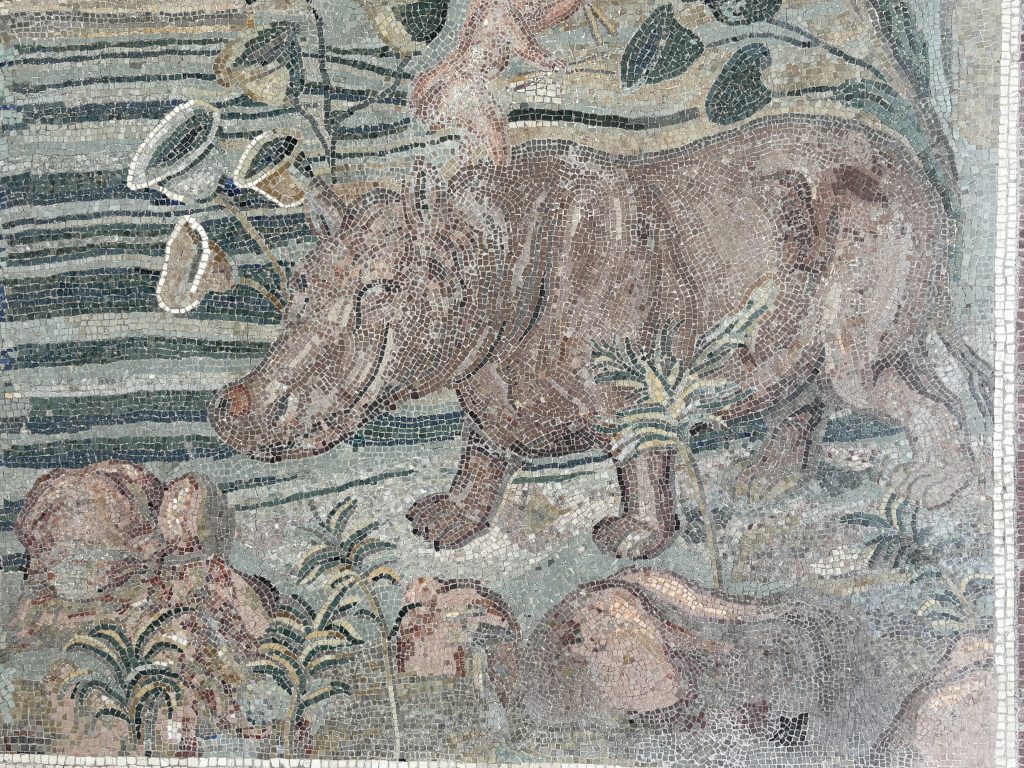
National Etruscan Museum of Villa Giulia (Museo Nazionale Etrusco di Villa Giulia)
Tucked away in a graceful Renaissance villa built for Pope Julius III, the Etruscan Museum offers a fascinating glimpse into Italy before Rome’s rise. Its collection of jewelry, pottery, and tomb sculpture reveals the elegance and sophistication of this early civilization.
A highlight is the Sarcophagus of the Spouses, a terracotta masterpiece radiating warmth and humanity. The museum’s peaceful gardens provide a refreshing pause from the bustle of central Rome.
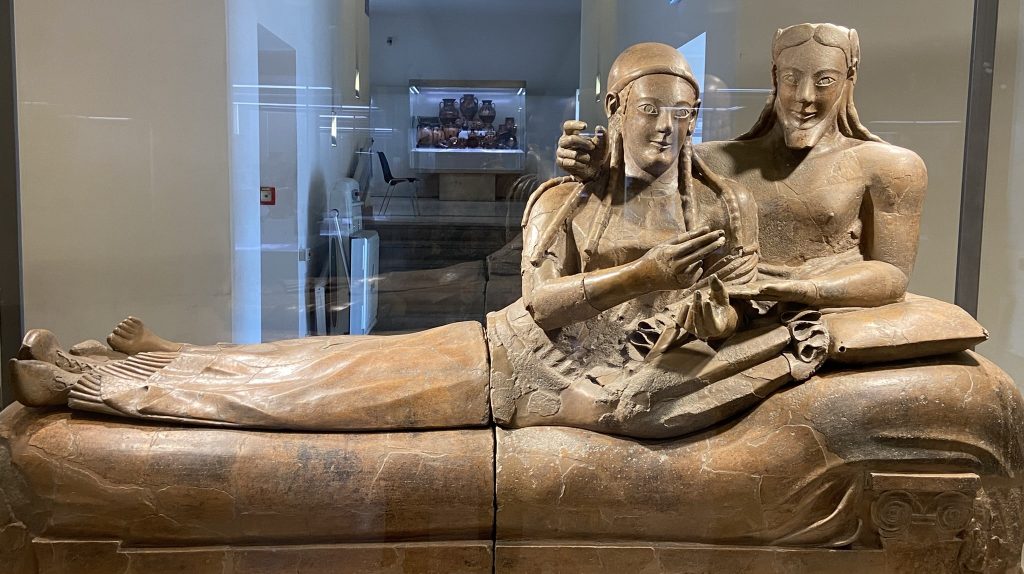
Day 2: Catholic Rome
Rome bristles with churches, some dating back to Roman times and most containing priceless works of art, particularly from the Renaissance and Baroque eras. You can’t see all the churches in one day, and nor should you try!
Focus first on St. Peter’s Basilica and the Vatican Museum and then go back across the Tiber to visit San Pietro di Vincoli and the Basilica of San Clemente.
St. Peter’s Basilica and the Vatican Museum
A visit to St. Peter’s Basilica and the Vatican Museum requires stamina. Line-ups are inevitable even with advance tickets.
You also can’t avoid the long, sweaty trek through room after room of the Vatican Museum before you finally arrrive at the Sistine Chapel.
But the trek is worth it. Just make sure you buy your tickets for the Vatican Museum well in advance.
Sistine Chapel & Vatican Museum
The Sistine Chapel heaves with tourists. There’s no escaping them (and you are one of them!) so just tilt your head back and admire Michelangelo’s ceiling.
My favorite memory of the Sistine Chapel is when I heard a woman behind me say to her companion, “Do y’all think it was done by hand?” I resisted the temptation to turn around and tell her it was paint by numbers.
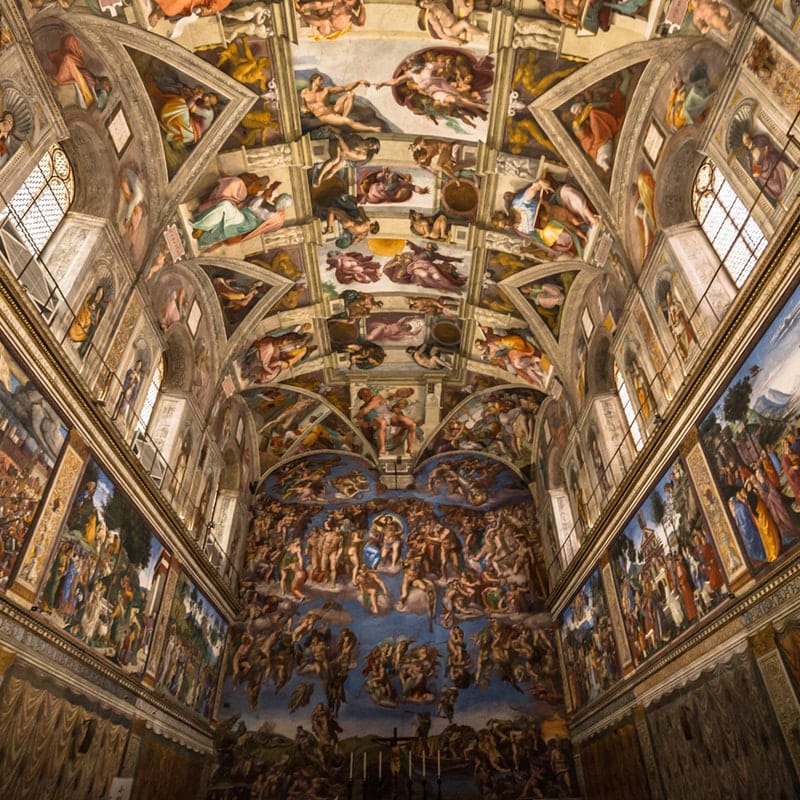
The Sistine Chapel was restored by Pope Sixtus IV, famous for his patronage of the arts. He also makes an appearance in the TV series Medici, which I write about in a post over on my sister website, Art In Fiction. Pope Julius II is responsible for commissioning Michelangelo to cover the ceiling with his magnificent frescoes between 1508 and 1512.
The Sistine Chapel is not the only attraction at the Vatican Museum, albeit the most famous. Follow the crowds through room after room after room of paintings, maps, sculptures, and more. A highlight is Raphael’s painting, The School of Athens.
St. Peter’s Basilica
St. Peter’s Basilica is a must-see because it is humongous. My favorite part is viewing the size of various world cathedrals marked in the nave. Washington’s National Cathedral is marked at 139 meters, which is about half the length of St. Peter’s nave.
The last time I visited St. Peter’s, the organ was at full volume and wow! Transfixing, for sure.
I love the exterior of St. Peter’s. A gorgeous double sweep of Bernini columns embraces two sides of the square.
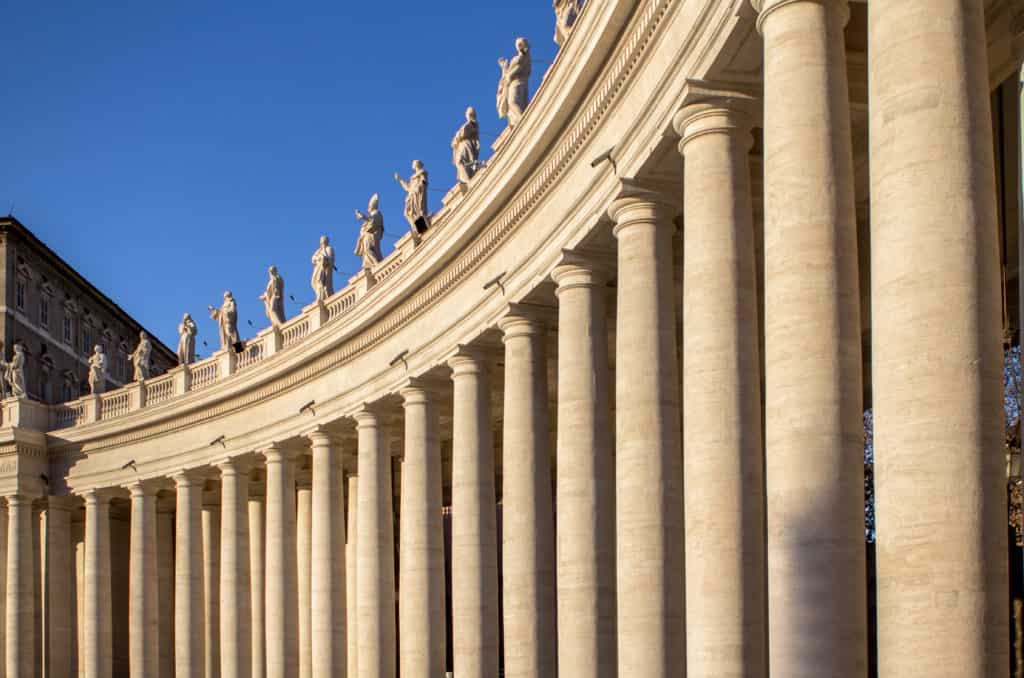
Castel Sant-Angelo
On your way back over the Tiber to central Rome, you’ll pass by the Castel Sant’Angelo. Also known as the Mausoleum of Hadrian, the site technically belongs with the ancient Rome Day 1 itinerary. However, its location near St. Peter’s and the Vatican makes it a good stop on Day 2.
Originally built to be the mausoleum for the Roman Emperor Hadrian and his family, the structure was later used by the popes as a fortress and castle and is now the Museo Nazionale di Castel Sant’Angelo.
The museum is a worthwhile stop, primarily because of the view of Rome seen from the top. Go at sunset for some great photo ops. The area around Castel Sant’Angelo teems with tourists, so seeing a view like the one below is virtually impossible!
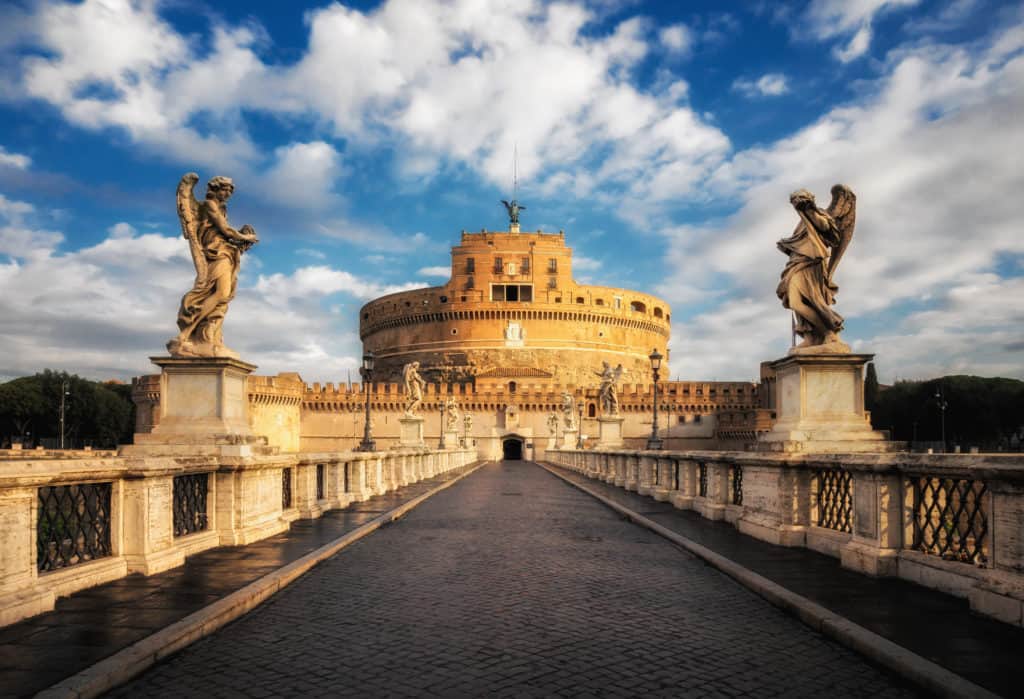
Cross the bridge from the Castel Sant’Angelo and plunge back into medieval Rome. Stay around the Piazza Navona for the rest of the day, enjoying gelatos and people-watching, or continue your Catholic Rome wanderings by visiting two more churches.
Take a bus or a taxi back towards the Colosseum area to find San Pietro in Vincoli.
San Pietro in Vincoli
Not far from the Colosseum are a few churches worth visiting, particularly San Pietro in Vincoli (Saint Peter in Chains) where Michelangelo’s statue of Moses dominates the side altar.
Whenever I’ve visited this church, it’s been quiet and uncrowded. I love standing in front of the Moses statue and admiring the way Michelangelo sculpted Moses’s hands. Truly remarkable.
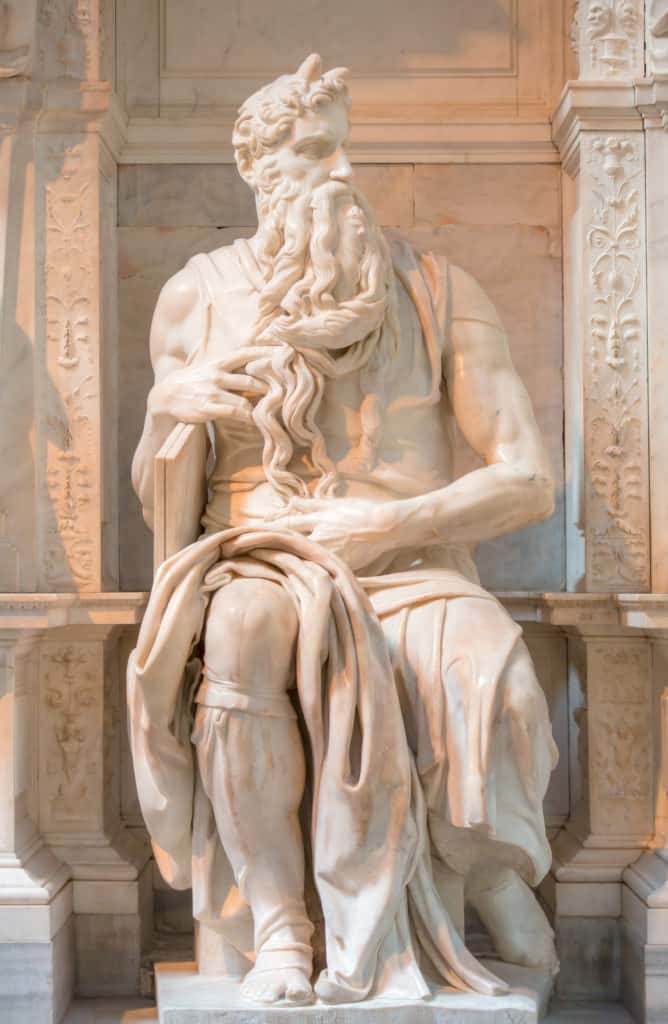
Basilica of San Clemente
Located not far from the Colosseum, the Basilica of San Clemente appeals to me because it was built on the site of a house containing a shrine of the Roman god Mithras. An underground passage leads to the excavated foundations of the 2nd-century Roman house. A relief on the altar shows the Persian sun god, Mithras, killing a bull.
The underground area is super dark and creepy, providing great scope for the imagination.
Photography Tour of Rome’s Churches
If you really love churches and photography, I recommend taking a Photography Tour of Rome with Rome Photo Fun tours instead of shuffling through the Vatican.
You’ll see plenty of awesome art, learn photography skills, and get off the beaten path. I wrote this post about my experience taking the Rome Churches, Angels, and Art Photo Tour.
Day 3: Pastoral Rome
Rome is not all churches and ruins. It also has the marvelous Borghese Gardens, the atmospheric Trastevere region, and the achingly pastoral Appian Way, several metro stops from the center of the city.
See the Galleria Borghese and the Borghese Gardens in the morning, zip out to the Appian Way for lunch and a lovely afternoon stroll, then end your day with dinner in the Trastevere neighborhood across the Tiber from central Rome.
Borghese Gardens and the Galleria Borghese
Head to the Borghese Gardens and tour the Galleria Borghese. You must get tickets ahead of time. This stunning gallery reopened recently after being renovated. You’ll see some of the masterpieces of the Baroque age, including works by Caravaggio and the famous sculptures of Apollo and Daphne and The Rape of Proserpina by Bernini.
Check out the way Pluto’s fingers press into Proserpina’s flesh and then remember that you’re looking at marble.
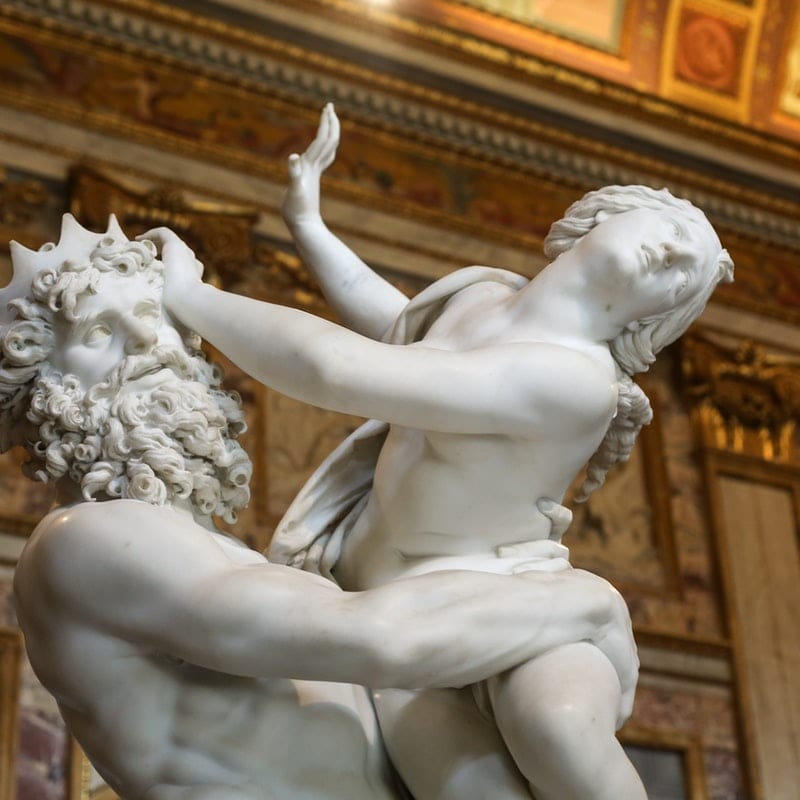
Amazing!
After partaking of the Baroque delights at the Galleria Borghese, spare an hour or so to wander around the gardens of the Villa Borghese. On a solo trip to Rome a few years ago, I stayed in a bed-and-breakfast about a block from the park and enjoyed early-morning strolls alongside Roman joggers.
Appian Way
In the afternoon, depending on the weather and your energy level, consider taking the metro out to the Appian Way (Via Appia Antica).
You’re transported from noisy modern Rome to an Arcadian landscape of plane trees and cypresses lining the original Roman road. Rent a bike or just stroll along the stone roadbed, imagining Roman chariots rumbling past.
Gregg and I spent a magical afternoon there, communing with the ghosts of the Roman rich people whose tombs line the road. The peace and quiet soothed nerves that can get a bit overstimulated by the hustle and traffic of downtown Rome.
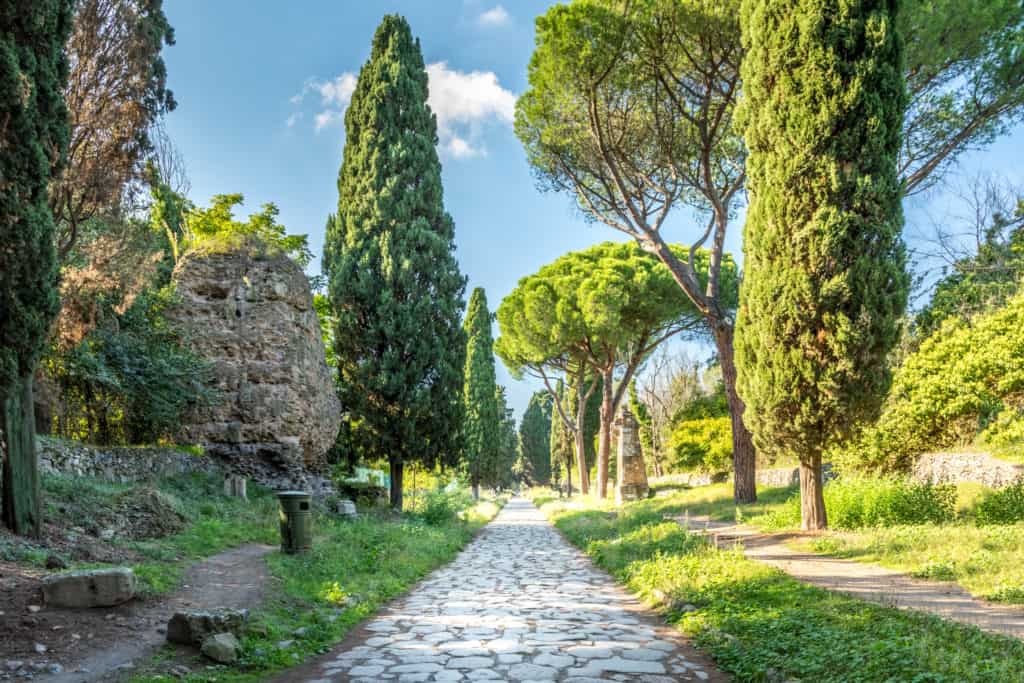
Trastevere
Spend an evening strolling the quiet streets of the Trastevere neighborhood. The working-class area still feels authentic and Roman. Find a small restaurant overlooking one of the piazzas and settle in for dinner.
Trastevere is located on the same side of the Tiber as St. Peter’s Basilica, about a ten-minute bus ride alongside the river.

Here’s a good article about what to do and see in Trastevere.
Rome FAQs
Here are answers to questions I’ve been asked most frequently about visiting and enjoying Rome:
Not really, but it’s better than two days! If you focus on the major sights (Colosseum/Forum, Vatican, Pantheon) and book skip-the-line tours, you can get a great overview in three full days. Just make sure you don’t over-do it. Better to skip a site and relax with a Aperol Spritz in a bar frequented mostly by Italians than to spend your time in hot, sweaty line-ups.
See Ancient Rome (Colosseum, Forum) sites on Day 1, preferably later in the day when the crowds may be thinner. Explore the Vatican and the Historic Centre (Pantheon, Piazza Navona) on Day 2. On Day 3 check out neighbourhoods (Trastevere, Appian Way) or tour some galleries (the Etruscan Museum is my favorite).
If you plan to use metro/bus/or hop-on tours frequently, a 48-hour transport pass can save money and time. Otherwise pay-as-you-go may suffice. If you want to conserve your energy, I suggest getting around with taxis. They cost more than the bus, but they are fast, easy to find and fun to ride. Watch the crazy traffic go by from the comfort of a car driven by a pro.
Staying in Monti or near the Spanish Steps gives you easy walking access to many major landmarks; Trastevere offers a charming evening atmosphere but is farther from sites in central Rome. Staying right down near the Piazza Navona is an excellent choice if you don’t mind crowds and like to be close to the action.
Tours in Rome
Here are some tours offered by Tiqets.com:
And here are some tours offered through GetYourGuide:
Fancy a walking tour? The tours offered through GuruWalks are a good bet. Here are their tours in Rome.
Where to Stay in Rome
If you’re staying in Rome for more than two or three nights, consider renting an apartment. I’ve had good luck with VRBO and booking.com.
When you stay in an apartment, you live like a temporary local, buying food from the local markets, and getting to know neighborhood restaurants and cafés.
Here are some good options:
The Sant’Angelo Apartments in the Jewish Ghetto area of Rome is very close to a lot of Roman ruins in addition to the Capitoline Museum and the Piazza Venezia, site of the Victor Emmanuel monument. The apartment I rented was quite spacious and the location can’t be beat for exploring ancient Rome.
I also recommend Viam 6B located between the Spanish Steps and the Piazza Popolo, a very upscale and chi-chi part of Rome with lots of designer stores. The apartment was very modern and comfortable and included a beautiful outdoor terrace.
I loved Torre Capranica just around the corner from the Pantheon in a crowded but exciting part of Rome. This 14th century renovated tower is staffed by friendly people and includes an elevator.
For more accommodation suggestions in Rome, see Recommended Plays to Stay in Italy That Will Make Great Memories or check the map below:
Conclusion
Here are some more posts to give you a taste of Italy or check Visiting Italy to see the full list of posts about Italy.
- Ten Must-See Art Masterpieces in Tuscany
- Beyond Romeo and Juliet: What to See in Verona, Italy
- Exploring Tuscany, Umbria and La Dolce Vita
- 3 Days in Venice: Best Itinerary for First-Time Visitors

[…] Rome […]